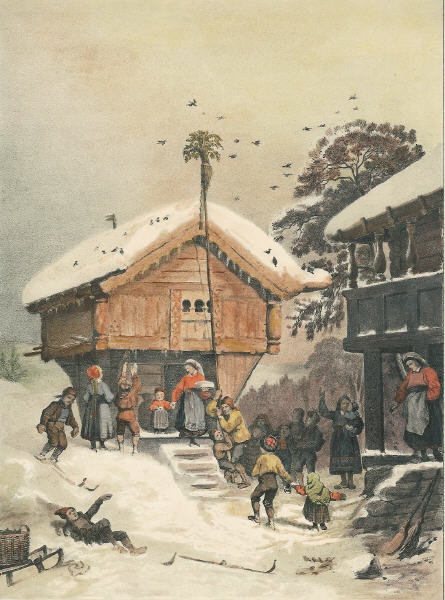The celebration of Christmas Day, interestingly, has its roots in ancient traditions that are essentially pagan. Even before the birth of Christ, some of our Christmas practices such as Christmas caroling, bonfires, exchanging of Christmas gifts, Christmas flower arrangements, Christmas hampers and the putting up of Christmas trees, decorated with Christmas ornaments inside our homes were already observed by ancient cultures across Asia and Europe.
But apart from the tradition of giving special Christmas gifts and sending season’s greetings during Christmas season, this holiday has significant history behind it. Find out the history of Christmas with the following Christmas information and trivia.
History Of Christmas:
The History Of Christmas is a long trail of different traditions and old celebrations. From years and generations back the Winter season and the year-end has been a time for festivity for many civilizations. Here we have collected the most interesting stories and history of Christmas.
 Christmas Celebration in Early Times
Christmas Celebration in Early Times
One of the early predecessors of the Christmas celebration was the “Zagmuk”, which was observed yearly by the Mesopotamians some 4000 years ago. It is believed in Mesopotamian mythology that every year during winter, their chief god Marduk, would go to fight in a fateful battle with the musters of chaos.
In accordance to that belief, the Mesopotamians held the Zagmuk- a 12-day long festival which was aimed to welcome the New Year. Through the Zagmuk the Mesopotamians try to assist Marduk in his struggle by sending him their King as his aid in fighting the monsters of chaos. However, sending the King to Murdok would entail that he should die at the end of the year in order to join Murdok in battle.
The Mesopotamians solved the dilemma by sending a criminal in place of the real King. The criminal is then dressed in royal garments and he was paid the same respect and privileges as they gave to the real King. At the end of the celebration, the false king will then be stripped of his royal garments and slain, and the real King will be spared.
A variation of the Zagmuk, which is called the Sacaea, was also practiced by the ancient Persians and Babylonians. Like the Zagmuk, the Sacaea too, involved slaves taking the place of their masters, and masters assuming the roles of the slave. Sacaea was a Babylonian five-day festival which was possibly their new Year celebrations. It was characterised by rogue behavior, drunkenness and reversal of roles. During the festive days a mock king was chosen from criminals who would be feasted and honoured for five days after which he would be stripped off his royal clothes and slayed. It was supposed that each year the King would die when a New king was born; the mock king made it easier for the King to stay alive and enjoy the festive season.
History of Christmas in Europe :

In early Europe, the history of Christmas had its beginnings in the winter solstice. During this season, the early Europeans worried about the sun disappearing. In their fear, they came up with rituals and practices that were aimed to make the sun come back. The Scandinavian version of the ritual involved sending scouts into the mountains to hunt for the sun. At the first sight of light, the scouts would then go back to the people to convey the good news. Then a festival would be held the Yuletide- where the Scandinavians lit bonfires, and exchanged “Strenae” or lucky fruits as a form of a good luck gift.
Another variation of the Zagmuk festival was the battle between Kronos and the Titans led by Zeus in Greek mythology.
But perhaps the celebration that best resemble contemporary Christmas celebration was the Saturnalia which took place in Rome. The Saturnalia take place in the days between mid-December to the first day of January. During the Saturnalia celebration, the ancient Romans decorated their halls with laurel garlands and uttered cries of “Jo Saturnalia” in the same fashion that people say “Merry Christmas” in contemporary times.
 Christianity and Christmas
Christianity and Christmas
With the rise of Christianity, the celebration of the Saturnalia was ordered to be stopped. In view of the Christians, the joyous celebration was disrespectful to the holiness of the birth of Christ. The opted for a solemn celebration and sought to abolish the Saturnalia, but they did not succeed. In order to cope with what they could not stop, the early Christians eventually agreed to allow the celebration, albeit in a modified form more fitting to the celebration of the birth of Christ.
According to some legends, Christmas was purposely invented to wipe out paganism. Hence, the date December 25 which was a holy day among Roman and Persian religions the biggest rivals of Christianity at the time.
The Birth of Christ – Christmas Day :
 Incidentally, the exact date of Christ’s birth was never known. Some say its celebration can be traced back to 98 AD, and was declared a solemn occasion in 137 AD by the Bishop of Rome. It was only in 350 AD when a specific date (December 25) was declared as the birthday of Christ.
Incidentally, the exact date of Christ’s birth was never known. Some say its celebration can be traced back to 98 AD, and was declared a solemn occasion in 137 AD by the Bishop of Rome. It was only in 350 AD when a specific date (December 25) was declared as the birthday of Christ.
Christmas Day eventually became the biggest religious celebration in Europe after Christianity was declared as the Roman Empire’s official religion. This is when Santa Claus became popular in Europe as the symbol of gift-giving and nativity scenes began to be portrayed in paintings and books.
The significance of Christmas day was questioned during the rise of Protestantism in the 15th century. According to the proponents of the Reformation, most of the customs that accompany the celebration of Christmas have no religious bearing. As a consequence, Christmas was banned in England and in some of her colonies in the New World. However, Christmas customs proved resilient and resurfaced over time as they became fused with Christian elements of the tradition.
Advent is considered as an important part of christmas celebrations. It corresponds with the four-week long celebrations. It celebrates the arrival of Baby Jesus . In many parts of Germany it is celebrated as Christmas. A special advent crown is made with woven fir branches and four candles which represent the four seasons of the year. The candles are lit up one by one on each sunday before Christmas day.
Christmas tree is also an important part of the celebration. The evergreen tree like Ivy or Holly symbolises eternal life. There are strange traditions of Christmas trees being decorated with biscuits, chocolates and sweets which can be savored from 24th December , but special care is taken to let the wrappers stay in place so that te tree does not look bare.
Since ages the winter solstice is celebrated by many countries as a day of celebration . Slowly when today’s Christmas came into existence most of the World followed but still many parts of Russia dn Europe celebrate Christmas in different days and different ways.



